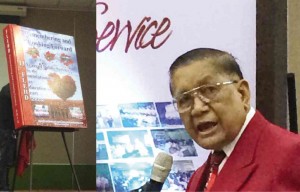Changing public attitudes toward heart disease prevention
Each year, hundreds of thousands experience a heart attack, and nearly half of them are fatal. Stroke is the leading cause of disability and the second leading cause of death in the country.
Foundation for Lay Education on Heart Diseases (FLEHD) founder and president Dr. Adolfo Bellosillo said: “Many people tend to think that breakthroughs in medicine—new drugs or latest high-tech surgical procedures—are the answer. But despite the medical and surgical advances, 60 percent of deaths occur suddenly and among the survivors, 30 percent die while in the hospital and the recurrence rate of heart attack remains high. They have a hard time believing that the simple choices that we make in our lifestyle—what we eat, how much exercise we get, how we respond to stress, whether or not we smoke cigarettes—can be as powerful as or even better than drugs and surgery.” FLEHD is an organization that primarily focuses on educating the Filipino community with regard to heart and related diseases.
Bellosillo, who also heads the Makati Medical Center’s Cardiac Rehabilitation and Preventive Cardiology Unit, recently launched a book chronicling the first 13 years of the foundation since its inception in September 1999.
“Through the support of the board of formidable trustees chaired by Jose Concepcion and with Ms Marixi Rufino-Prieto, Ms Imelda Cojuangco, Ms Nellie Bengzon, Dr. Alberto Romulo, Johnny Litton, Ms Zenaida Tantoco, Dr. Norbert Lingling Uy and me as members (also included were Enrique Sobrepeña who resigned and Ms Chito Madrigal Collantes who passed away), FLEHD was able to conduct more than 400 educational programs—in various formats—nationwide,” said Bellosillo during the book launch held at the Makati Medical Center auditorium (8th floor of Tower 2) last Monday.
Educational programs
The educational programs the foundation has initiated include: public health forum for the general population with topics like “Know your heart and how it works,” “How do I know I am having a heart attack?” and “Sex and the Heart: Fact and Fiction” presented in layman’s terms; barangay health workers workshop, which was conceived to enrich basic knowledge of barangay health workers on matters pertaining to heart and cardiovascular system; senior citizens seminar; annual national convention on preventive cardiology for physicians; annual regional assembly on preventive cardiology, which is designed for physicians who find it difficult to come to Manila to attend the national convention; and annual oratorical contest, which is held to create awareness among medical students all over the country on the importance of preventive cardiology as a big factor in reducing cardiovascular mortality and morbidity.
Other educational programs are: healthcare professionals in government service, which is designed for the provincial, city and municipal health officers, including their nurses, midwives, nutritionists and dieticians; public school teachers seminars; preventive cardiology seminars for nurses; “How to Remain Young at Heart: The Musical” presentations, which merged medical lecture with music and dance; publication of a primer on coronary artery disease, which contains most of the pieces of information used during FLEHD forums, seminars, assemblies, etc. and has been translated into various dialects namely: Tagalog, Ilonggo, Cebuano, Ilocano, Pangalatok, and Pampangueño.
Bellosillo explained: “I should thank the FLEHD faculty who are volunteer doctors gifted with thorough knowledge of heart diseases and effective communication skills. What we have proved in all our initiatives is that changing lifestyle could prevent at least 90 percent of all heart disease, and likely even more. Thus, the disease that accounts for more premature deaths and costs Filipinos more than any other illness is almost completely preventable, and even reversible, simply by changing lifestyle.”
He added: “If FLEHD continues to address the underlying causes of chronic diseases, which are largely dependent on lifestyle changes, and provide incentives for healthy ways of living, we can create a new model of medicine that is more caring and compassionate, and that is also more cost-effective and competent.”

